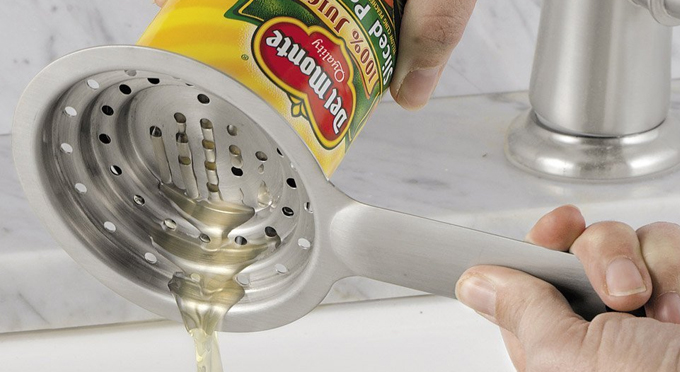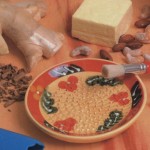 You know how you normally do it.
You know how you normally do it.
You take the recently removed lid, with it’s dangerous jagged edge, and you carefully remove it from the can. Then you position it over the can opening, and use one hand to hold it in place while tipping the can over with your other hand. If everything goes right, you’ll end up separating the liquid from the other stuff, but you’ll have to be careful to prevent spilling or injury, and you can almost guarantee that some of the juice will end up coating your fingers in the process.
Wouldn’t it be nice to get at the contents inside cans and jars without having to touch the sticky or stinky liquid inside? Of course it would. And who wants to learn some special technique, or risk getting cut just to eat some canned fruit? Not you. Right?!
Why Is The Liquid In There Anyway?
We know what you’re thinking. Why the heck is that annoying juice in there in the first place?
Well, the short answer is because it’s necessary.
The liquid inside your cans and jars is essential to the preservation process, so you won’t be able to avoid it, and there’s no way currently to effectively preserve foods in cans and jars without submerging it in liquid. In most cases, water is added to the food in order to create the vacuum necessary for safe pressure heating.
Food companies use this process to allow for a long shelf life, ensure safety, and to retain flavor and nutritional value. This simple technique causes food to remain edible for a long period without the use of preservatives, so the end result is healthy, long lasting food. The main draw back to this process is that when it’s time to consume the food, you’ll have to drain the liquid first.
Should The Liquid Be Drained?
If you’re concerned about pouring vitamins and nutrients down the drain when straining your canned fruits and vegetables, worry no more. Some amount of the good stuff will inevitably leach out into the liquid, but it’s a very small percentage. When you dump out a can, most of the liquid will be water, and even if it’s thick or colored, you can be sure that most of the important stuff is still inside the fruits and veggies that remain in the can.
If you’ve ever tasted the water surrounding your beans, peas or corn, then you probably noticed that it’s pretty darn salty or sweet in most cases. One good reason to drain the can is to avoid adding this extra salt and sugar to your diet. There’s also some data to suggest that metallic tastes and unwanted chemicals can leach into the water from the can itself, or the liner inside. If you don’t want to risk that kind of stuff, then draining the liquid and rinsing the contents can help to eliminate much of this undesirable contamination.
A Universal Can Strainer
Dumping out a can the traditional way might be OK if you’re dealing with peaches or pears because the juice is light and sweet, but when draining a can of tuna it’s a whole different story. The water or oil inside a can of tuna fish is quite pungent, and if it touches your fingers, you’ll probably be smelling ti for the rest of the day, even if you wash several times. If you would prefer to avoid the foul odor, and the chore of scrubbing each finger, then our Universal Can Strainer may be just what the doctor ordered. It’s able to adapt to any size can, and it allows you to quickly separate the food from the liquid with very little effort, and absolutely no exposure to your skin.
What Is It?
It’s basically a tiny colander with a long handle. It has three different basket sizes for a universal fit, and it’s made from 18/8 stainless steel for long lasting performance, and an upscale look. You can position it so the straining basket pushes in on the food to press out a maximum amount of liquid, or you can flip it over so the food will gently spill out and drain at the same time, in order to prevent damage to delicate fruits and vegetables. Several holes in each basket allow liquid to pass through quickly, and the wall around the outside prevents any little chunks from spilling out as you pour.
How To Use It
This handy gadget is incredibly simple to use, so anyone will be able to avoid sticky and foul smelling liquids when removing liquid from canned foods.
- Simply remove the lid like normal and set it aside.
- Place the strainer over the top of the can so that the container is positioned inside the smallest basket it will fit in.
- For most applications, you’ll want the basket to curve over the can, but for stuff like tuna, you may want it to curve in toward the center of the can. When it faces inward you can easily press out nearly every drop, and when facing out it will act more like a bucket that the food can gently pour into.
- Once the strainer is positioned, hold it with one hand, and take the can or jar in your other hand.
- Tip over above your sink to drain liquid.
- The deep basket will prevent any loss of food, and the numerous holes will allow the water to drain quickly.
Never worry about squished fruit, run away peas, or stinky fingertips again. Just because you’ve always used the can lid to hold stuff in does not mean it’s a good technique, or one you should continue using. How many times have you bent the lid, crushed your food, spilled half the can, or watched as annoying liquid spilled all over your hands? With this handy tool in your kitchen you’ll be able to drain liquid faster, and you’ll never have to touch the possibly yucky stuff inside, unless you want to.
Other Ways To Drain Canned Food Without Touching It
Draining canned food without touching the contents or making a mess can be achieved with a few simple techniques. You could use the high quality tool mentioned above, but you could also try other techniques with stuff you already have at home. Before you head to the store, here are some other methods you can try:
1. Use a Strainer or Sieve:
Place a fine-mesh strainer or sieve over a bowl or sink. Open the can partially, leaving a small gap. Hold the can upside down over the strainer and gently shake or tap it to drain the liquid. The contents will stay inside the can while the liquid drains through the strainer.
2. Use The Invert and Tap Method:
Open the can partially, leaving a small gap. Hold the can upside down over a sink or a plate with a rim. Tap the bottom of the can with a spoon or the edge of a countertop to encourage the contents to slide out while the liquid drains.
3. Puncture and Drain:
Use a can piercer or a church key-style can opener to puncture a small hole in the bottom of the can. Hold the can over a sink or container, and the liquid will drain out through the hole.
4. Use a Can Strainer or Dedicated Canned Food Drainer:
There are specialized can strainers available that attach to the top of the can. These strainers allow you to drain the liquid without touching the contents. They often come with a lever or button for easy control. Some kitchen gadgets are designed specifically for draining canned foods without making a mess. These devices often have a spout or channel to direct the liquid away from the food.
Each of these tools will be similar to the strainer featured above, but there are many variations if you look around. If you get one of these, decide which features are most important to you, and then make a decision.
5. Use The Freeze and Pop Method:
If you plan to use the canned food in a recipe that doesn’t require the liquid, you can freeze the can for a short time. Once the liquid has frozen, use a knife or spoon to pop the frozen liquid out of the can, leaving the solid contents inside.
Choose the method that suits your needs and the type of canned food you’re working with. Each method has its advantages, so you can select the one that works best for your situation and equipment availability.





 Ordering Info
Ordering Info Customer Service
Customer Service Follow Us
Follow Us Search For Stuff
Search For Stuff Find Us
Find Us Call Us
Call Us Pay Us
Pay Us

0 Comments so far.
Use the form below to add your own thoughts or questions. Scroll down to read what other people had to say.